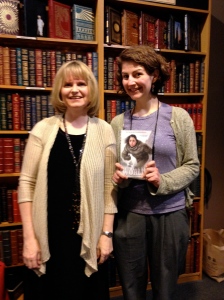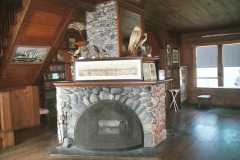Susan: What made you realize you wanted to be a writer? Do you have any advice for aspiring writers?
Katherine: In the sixth grade, I wrote a story about vampire bats attacking a scientist. That year I won my first English prize, the first of many, and writing became “my thing.” I followed a family pattern. My mother did quite a lot of writing, and my brother Sidney (see http://en.wikipedia.org/wiki/Sidney_D._Kirkpatrick), sister, cousin, and grandfather chose careers in writing and/or publishing.
My advice to aspiring writers is to take all assignments, paid and unpaid. Contribute to your school’s alumni magazine and local newspaper. Think about what organizations you belong to. Blog. Write a heartfelt reminiscence when your favorite teacher retires. Volunteer your talents, make people laugh, feel appreciated, hone your skills. I’m so proud of the biography of my father I self-published, The Dale Kirkpatrick Story (http://www.lulu.com/spotlight/allegra1943).
Susan: Why did you choose to write historical fiction for young adults?
Katherine: My mother loved history and partly for that reason my parents chose to settle in a community rich in colonial and maritime lore, the Three Villages (Stony Brook, Setauket, Old Field), Long Island, New York. My family liked to tour historic houses and visit old cemeteries and our local carriage museum http://longislandmuseum.org/, which has a jauntily painted American gypsy wagon, circa 1870, that always captured my imagination. Once I took a children’s writing class held in the museum’s 18th-century one-room schoolhouse.
When I started to write novels, I found myself drawn to the coming-of-age themes of independence, discovery, maturity, and relationships in young adult fiction.
Susan: Where did you get the idea that sparked Between Two Worlds?
Katherine: In the Hall of Meteorites at the American Museum of Natural History in New York, I noticed a photo of four-year-old Marie Peary, the daughter of Arctic explorer Robert E. Peary, onboard a ship with a gigantic meteorite. After researching Marie’s life, I started a novel. I showed it to editor Mary Cash at Holiday House, along with stunning photographs of Marie in Arctic Greenland. With the photos in mind, Mary encouraged me to write a nonfiction book, The Snow Baby, http://www.katherinekirkpatrick.com/book_01.html, published in 2007.
Years later I returned to the novel. It took on new life when I decided to switch perspectives, telling the story from Billy Bah’s, an Inuk girl’s, point of view.
Susan: I really enjoyed reading The Snow Baby! Can you tell us a little bit about your work writing both fiction and nonfiction, and how one approach may inform the other?
Katherine: I’d published four novels before I wrote The Snow Baby, so I brought to that photo essay/biography the novelist’s ability to think in terms of drama and scenes. After eight years of publishing nonfiction books, I returned to fiction with Between Two Worlds. Because I’d already researched Arctic Greenland, I focused on plot and character development without thinking so much about getting the history right. It’s been my tendency, like globbing on too much icing on a cake, to pile on historical details. This time around I started with the cake itself and with better results; Between Two Worlds has received excellent reviews.
It’s not a good idea, career-wise, to do the kind of zigzagging between genres that I’ve done. To establish a readership, it’s best to do the same kind of book over and over, preferably with the same publisher. But there’s value, too, in publishing individual titles. A friend of mine puts it this way: “Go to the party where you’re invited.”
Susan: Between Two Worlds is based on a true story. What’s real and what’s made up?
Katherine: About 80 percent of the book is based on historical events. Sixteen-year-old Billy Bah joined the Peary family on his ship Windward, which became locked in ice for eight months in 1900-1901. Just about everything but the triangle love story and conversations with the ancestor-ghosts is historically based.
Susan: Tell us about the real Billy Bah.
Katherine: Billy Bah, also known by her Inuk name, Eqariusaq, was born around 1884 in a remote coastal area of Arctic Greenland. When she was about eleven, she spent a year in Washington, D.C. with Peary’s family. She was both orphaned and married around age fourteen. Peary referred to her as his most expert seamstress. She sewed the fur coat that explorer Matthew Henson wore during the famed Peary expedition of 1909 to the North Pole.
Susan: The setting of 1901 Arctic Greenland plays a distinct and significant role in the novel. Also, you use a lot of Inuktun (Polar Eskimo) words in the book. Were these challenges for you, in terms of making Billy Bah’s story come alive for YA readers?
Katherine: The key to historical fiction is to put the past into the present, to bring out universal themes that a modern-day audience can relate to such as the desire to belong or the need for independence. No matter when, people have always shared many of the same core fears and desires. One common teenage dilemma is that at some point we must act under pressure and make difficult choices. The theme of romantic love is also powerful and universal. Billy Bah’s love affair with the sailor Duncan is the aspect of the book that I feel will most appeal to teen girl readers, fully drawing them into 1901 and the foreign world of Arctic Greenland.
In earlier drafts, I used a lot of Inuktun words. My editor Wendy Lamb cut out most of them, smoothing out the prose, while skillfully leaving in hints of the native sounds. Wendy also had me tone down aspects of traditional Inuit life that modern readers might find off-putting. I deleted the gory chapter in which Billy Bah’s people slaughter walruses and downplayed the cultural norms of uncombed hair, unwashed bodies, head lice, and body lice. Over five rewrites, Billy Bah became more assertive, more mature, and less historically Inuit in terms of personal hygiene.
Susan: What’s the most unusual thing you’ve had to Google for a work in progress?
Katherine: I researched Inuit women washing their hair with urine. It would have put off readers, so I ended up not including that info. Again, sometimes we need to sacrifice a little accuracy for accessibility.
Susan: We all struggle to maintain “balance” in our writing lives. Could you describe your typical writing day?
Katherine: I block out about fifteen hours of morning time, Monday to Friday, for writing, and this time is for writing only. I’ll work in email or phone calls before or after, and in between my family-related commitments, such as taking my 90-year-old father-in-law to his medical appointments and my two middle-school-age children to their music lessons and other activities. I also try to squeeze in exercise time. I like to cook and we make a sit-down dinner a priority. Though I don’t write in the evenings or on weekends, I’ll sometimes do work-related reading or editing. Evenings I like to relax with my cat and play the harp.
Susan: What are you working on now?
Katherine: My novel in progress is set in England and Egypt in 1922-1923, during the opening of King Tut’s tomb. Two years ago, with my sister, brother-in-law, and niece, I visited the book’s Egyptian settings. We toured archaeological sites by small boat on the Nile and flew over the Valley of the Kings in a hot air balloon. This past April, during a family trip to England, I visited my novel’s main British setting, Highclere Castle in Berkshire, outside of London, for the second time. Highclere is now popular as the set for the hit British TV series “Downton Abbey.” I’ve been enjoying myself researching and writing, and I hope that spirit of fun and adventure will go into the book.
Susan: What was it like to have the great Madeleine L’Engle as a writing teacher?
Katherine: Madeleine was the most extraordinary person I’ve ever known. Quite tall, regal, and magnificent in her long purple and blue dresses and exotic jewelry, she projected the same sense of wonder as her classic fantasy novel A Wrinkle in Time. She was more than a little like the three otherworldly presences Mrs. Who, Mrs. Whatsit and Mrs. Which. Her expansive vision included a belief in angels, whom she was sure appeared regularly to all of us. She emanated power, knowing, and love, and had a great talent for bringing out her students’ inherently good qualities.
As a writing teacher she wasn’t what you would expect. Instead of talking about plot, character, or story structure, she preferred more abstract themes about the larger role of writing and art in our lives, such as the concept of story being truth. Invariably she advised, “Write for an hour. Don’t think. Attempts to direct only interfere with creative work.” Her belief about writing was that it’s an entry into the larger Cosmos. Publishing books is a happy by-product, she said. The shared journey is what matters.
In the ten years I knew Madeleine, she taught me about the life of spirit and the value of community. I met most of my closest friends through her. To learn more about Madeleine as a teacher, see the book I edited, A Circle of Friends: Remembering Madeleine L’Engle ( http://www.katherinekirkpatrick.com/book_02.html ).
Thanks for interviewing me, Susan!
* * * * *
This interview was previously published in abbreviated form on the fabulous historical fiction blog “Corsets, Cutlasses, & Candlesticks” http://corsetsandcutlasses.wordpress.com/ on June 30, 2014.











